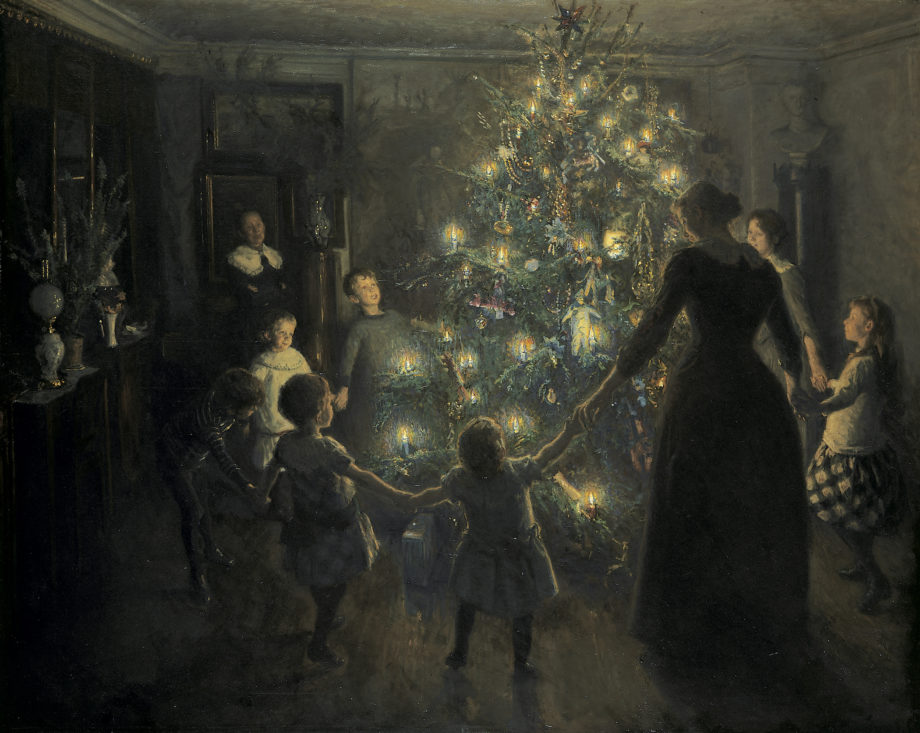FROM LEAF: LEAF is a partnership between the Wisconsin DNR-Division of Forestry and the University of Wisconsin-Stevens Point's Wisconsin Center for Environmental Education - a center of the College of Natural Resources and University of Wisconsin Cooperative Extension.

Painting by Viggo Johansen (1891)
The evergreen has been used in winter celebrations for centuries. Long before it represented Christmas, Europeans saw the evergreen as a symbol of hope and renewed life during the winter months when most plants were barren. The Christmas tree, as we think of it today, didn’t appear until the 16th century when Germans began decorating evergreens, known as “Paradise Trees” in celebration of “The Feast of Adam and Eve”. German immigrants introduced the custom to North America in the 1600s, and the tradition became widely adopted after President Franklin Pierce decorated a Christmas tree in the White House in the mid-1850s.
That’s a bit of Christmas tree history, but what do you know about today’s (real) Christmas trees? In 2002 in the United States, more than 22,000 tree farms covered 447,000 acres and cut over 20 million Christmas trees. According to Wisconsin Ag in the Classroom, our state is home to 1,387 Christmas tree farms covering over 36,000 acres of land and producing around 1.8 million Christmas trees.
As a symbol of the holiday season, we often forget about the wide-ranging economic and environmental impacts of the Christmas tree. For instance, Wisconsin’s Christmas tree industry, ranked 5th in production, brings in over $50 million dollars annually, and each acre planted provides the oxygen requirements for 18 people.
So, as you enjoy your Christmas tree this holiday season, remember its long history and all the benefits it provides. To learn more about the Christmas tree, visit Christmas Tree Fast Facts provided by Wisconsin Ag in the Classroom.
The evergreen has been used in winter celebrations for centuries. Long before it represented Christmas, Europeans saw the evergreen as a symbol of hope and renewed life during the winter months when most plants were barren. The Christmas tree, as we think of it today, didn’t appear until the 16th century when Germans began decorating evergreens, known as “Paradise Trees” in celebration of “The Feast of Adam and Eve”. German immigrants introduced the custom to North America in the 1600s, and the tradition became widely adopted after President Franklin Pierce decorated a Christmas tree in the White House in the mid-1850s.
That’s a bit of Christmas tree history, but what do you know about today’s (real) Christmas trees? In 2002 in the United States, more than 22,000 tree farms covered 447,000 acres and cut over 20 million Christmas trees. According to Wisconsin Ag in the Classroom, our state is home to 1,387 Christmas tree farms covering over 36,000 acres of land and producing around 1.8 million Christmas trees.
As a symbol of the holiday season, we often forget about the wide-ranging economic and environmental impacts of the Christmas tree. For instance, Wisconsin’s Christmas tree industry, ranked 5th in production, brings in over $50 million dollars annually, and each acre planted provides the oxygen requirements for 18 people.
So, as you enjoy your Christmas tree this holiday season, remember its long history and all the benefits it provides. To learn more about the Christmas tree, visit Christmas Tree Fast Facts provided by Wisconsin Ag in the Classroom.

No comments:
Post a Comment